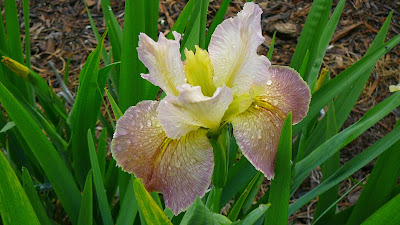by Ron Killingsworth
 |
| 'Barbara Elaine Taylor' (J. C. Taylor, 1954) |
I receive many pictures of Louisiana Irises submitted on the internet by members of
The Society for Louisiana Irises (SLI) during bloom season. I save the pictures and often spend time looking back at them during the cold winter months when nothing is blooming.
'Barbara Elaine Taylor' is an example of an "oldie but goodie" that continues to put on a show in the garden. The older more open form with stands that stand up is one of my favorite forms within the Louisiana irises.
 |
| 'Ann Weeks' (Jeff Weeks, 2010) |
Jeff Weeks hybridized this wonderful iris with some unique coloring. It too is one of the older forms of Louisiana irises that continues to be popular. The pollen parent is
'Wheelhorse' (Caroline Dormon, 1952) and you can see this new hybrid inherited the form from the pollen parent, where the petals look like a wheel.
 |
| 'Arachnaphobia' (Kevin Vaughn, 1997) |
Although I have never viewed this iris in person, I have seen quite a few pictures of this lovely spidery form iris. It has a very nice reddish color with some darker veining. It looks very much like some of the species Louisiana irises and I just love this form.
 |
| 'Ardoyne' (Joe Musacchia, 2003) |
|
A beautiful Louisiana iris with a Louisiana name, produced by the Regional Vice President elect of Region 10 of
The American Iris Society, Joe Musacchia. Joe actually lives south of New Orleans and is about as far south as you can go without driving into the Gulf of Mexico!
 |
| 'Birthday Suit' (Pat O'Connor, 2010) |
There is a shortage of pink irises in my opinion. Although registered as white,
"Birthday Suit" shows a lot of pink. Pat O'Connor lives just north of New Orleans and has introduced many beautiful irises.
 |
| 'Cajun Merry' (Mary Dunn, 1995) |
Mary Dunn produced hundreds of beautiful irises. This is registered as "ecru mauve" but, it looks pinkish to me. It is a beautiful iris with a distinctive red outline around the signal.
 |
| 'Cassiope' (Anfosso, L, 1988) |
I do not know Mr. Anfosso nor do I know which SLI member took this picture (please let me know so I can give you credit!) but it is certainly a beautiful example of some fine photography. Stands that stand up and falls that fall down are rare in modern day hybrid Louisiana irises.
 |
| 'Chuck Begnaud' (Dormon Haymon, 1999 |
Dormon Haymon, from Lafayette, LA, hybridized many beauties and this is certainly one of them. I really like the serrated edges with the slight white halo.
 |
| 'Cocka The Walk' (Joe Musacchia, 2005) |
You have to love the way the stands stand up so tall and the falls fall down and curve under. This is a very tall iris and can be seen in the garden from quite a distance.
 |
| 'Come In Spinner' |
I could not find any registration information concerning this iris. It could be still hanging around on a "garden" name. Regardless, there are few Louisiana irises that have this form in which all the petals fall down and leave the style arms standing up. If anyone knows more about it, please comment below.


















































